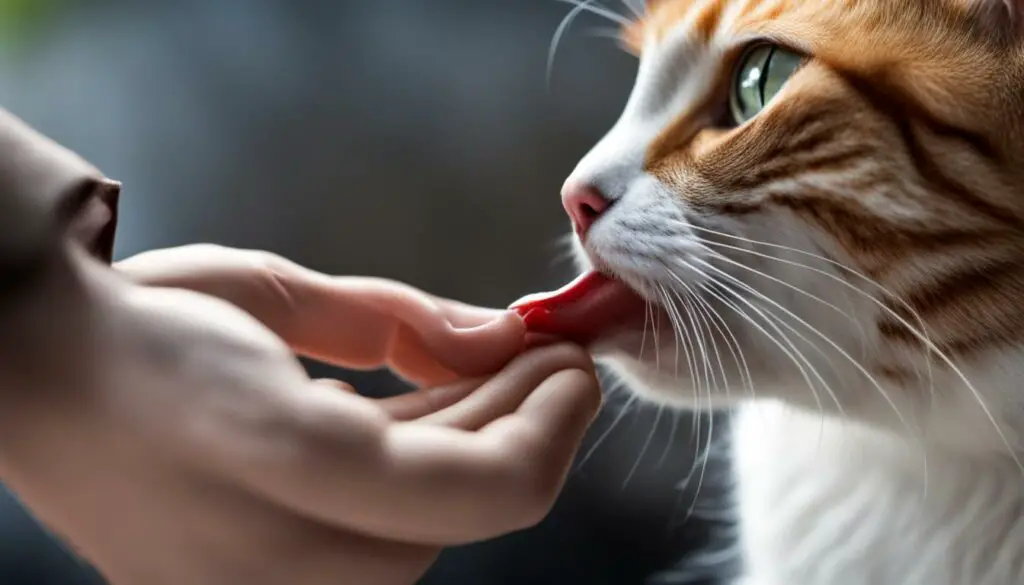Greetings fellow cat owners! Have you ever found yourself wondering why your beloved feline companion sometimes bites you seemingly out of nowhere? Well, you’re not alone. Many cat owners experience this puzzling behavior and may feel confused or even hurt by it. But fear not, for I am here to shed some light on the reasons behind this enigmatic cat behavior.
Cats, as we all know, have their own unique personalities and quirks. Understanding their behavior is key to building a strong bond with them. So, let’s delve into the various factors that contribute to unprovoked biting and explore how we can better navigate these situations.
Key Takeaways:
- Cat biting can stem from different factors, including play mode, overstimulation, fear or stress, and love bites.
- Recognizing warning signs and handling situations appropriately is crucial to maintaining a harmonious relationship with your cat.
- Redirecting your kitten’s biting behavior through appropriate toys and playtime can help teach them appropriate behavior.
- Understanding your cat’s limits during petting sessions and recognizing subtle warning signs can prevent petting aggression.
- Identifying and addressing triggers of fear or stress can help alleviate aggression in cats.
Play Mode: Teaching Kittens Appropriate Behavior
Kittens naturally engage in play biting as they develop their hunting skills and learn to communicate with their littermates. This behavior is a normal part of their development, but it’s important for owners to teach them appropriate behavior to ensure they don’t continue to bite as they grow older. When a kitten unintentionally bites too hard during play, punishing them is not an effective solution. Instead, redirecting their focus towards appropriate toys can help them learn what is acceptable to bite into.
One effective way to redirect a kitten’s play biting is to have a variety of toys available that are specifically designed for them to chew and bite. These can include soft plush toys, interactive puzzle toys, and small balls. By providing kittens with a range of options, they can learn which toys are appropriate to bite into and which ones are off-limits.
It’s also important to set clear boundaries during playtime. If a kitten bites too hard during play, let out a gentle yelp or say “ouch” to signal that they have crossed the line. This mimics how their littermates would respond and teaches them that biting too hard ends the play session. After giving this signal, immediately redirect their attention to an appropriate toy and continue playing.
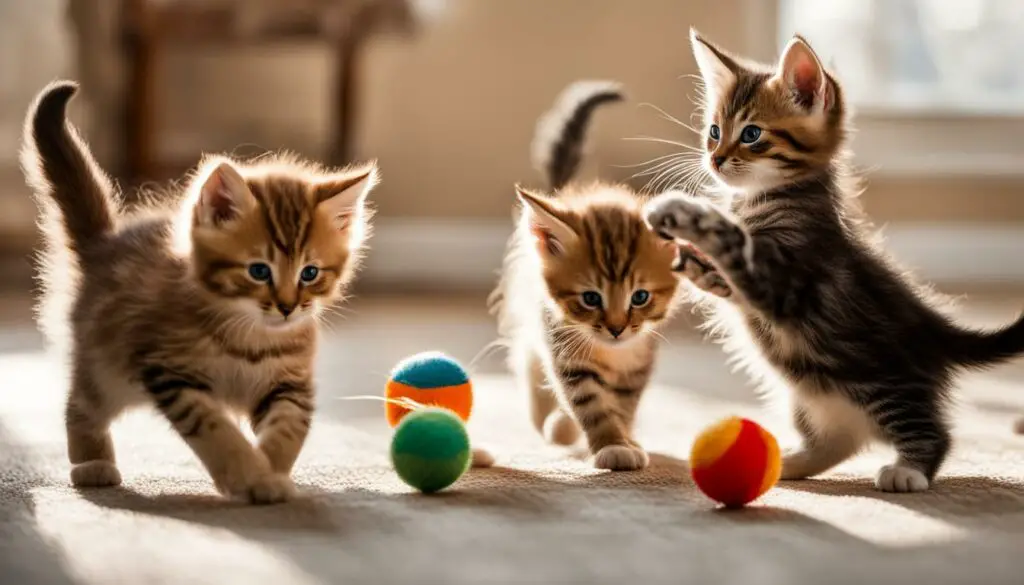
Consistency is key when teaching kittens appropriate behavior. It may take time for them to understand which behaviors are acceptable, but with patience and positive reinforcement, they can learn. Remember to reward them when they choose to play with their toys instead of biting you. By redirecting their play biting and providing them with appropriate outlets for their energy, you can help them develop good habits and create a harmonious environment.
Petting Aggression: Understanding Your Cat’s Limits
When it comes to petting aggression in cats, it is important to understand your feline friend’s limits. Cats may exhibit unprovoked biting when they become overstimulated during petting sessions. This type of aggression can be distressing for both the cat and the owner. By recognizing the subtle warning signs and adjusting our approach, we can create a more comfortable environment for our cats.
Subtle warning signs that a cat is becoming overstimulated include tail swishing, flattening of the ears, and twitching of the skin. These are indications that the cat may be reaching their limit and becoming uncomfortable. It is crucial to give cats space and respect their boundaries during petting sessions. This means paying attention to their body language and stopping petting when they show signs of overstimulation.
It’s also important to remember that every cat is different and may have different preferences when it comes to petting. Some cats may prefer shorter petting sessions, while others may enjoy longer sessions. It’s up to us as owners to recognize and respect our cat’s preferences. If a cat walks away or shows signs of discomfort during a petting session, it’s best to give them the choice to leave and wait for them to approach us again when they are ready for more interaction.
By understanding and respecting our cat’s limits during petting, we can prevent petting aggression and ensure a more harmonious relationship with our feline companions. Remember, a happy and comfortable cat is a cat that is more likely to show affection and enjoy our company.
Summary:
- Cats may exhibit unprovoked biting when they become overstimulated during petting sessions.
- Subtle warning signs include tail swishing, flattening of ears, and twitching skin.
- Respecting a cat’s boundaries and recognizing their preferences can help prevent petting aggression.
- Pay attention to your cat’s body language and give them the choice to walk away if they are uncomfortable.
Table: Signs of Overstimulation in Cats
| Signs of Overstimulation |
|---|
| Tail swishing |
| Flattening of ears |
| Twitching skin |
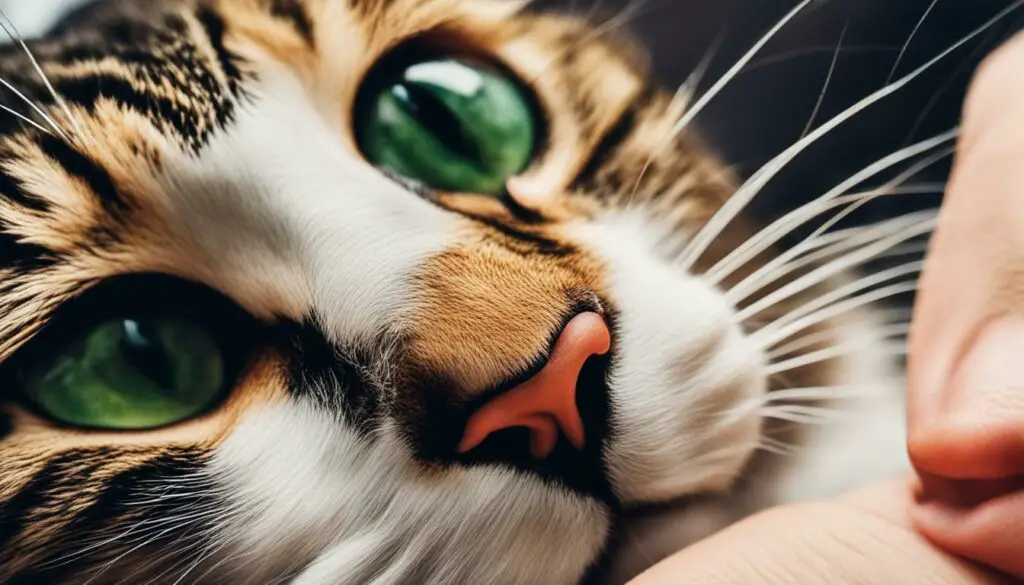
Fear or Stress: Identifying and Addressing Triggers
Cats may exhibit aggression when they feel fearful or stressed. It is essential to recognize the signs of fear or stress to address these triggers effectively. Some common signs include hissing, defensive posturing, and changes in body language. Identifying the cause of fear or stress is crucial for finding the right solution.
Table: Common Triggers of Fear or Stress in Cats
| Triggers | Examples |
|---|---|
| Veterinary visits | Being handled by strangers, unfamiliar smells |
| Changes in living conditions | Moving to a new home, introduction of new pets |
| Introductions to new people or animals | Strangers visiting the house, new pets in the household |
In some cases, aggression may also be a result of underlying medical conditions. If your cat’s behavior suddenly changes, it is important to consult a veterinarian to rule out any potential health issues.
“Cats may exhibit aggression when they feel fearful or stressed. It is crucial to address the underlying triggers and provide a safe and supportive environment for your feline companion.” – Dr. Jane Doe
Recognizing Fear or Stress in Cats
Fear or stress in cats can be identified through various signs and behaviors. These may include hissing, defensive posturing, hiding, excessive grooming, or changes in appetite and litter box behavior. Observing your cat’s body language can provide valuable insights into their emotional state. Offering a safe space and avoiding stress-inducing situations can help alleviate fear or stress-related aggression.
By helping your cat cope with fear or stress, you can create a more peaceful and harmonious environment for both of you.

Love Bites: Affection or Communication?
Love bites from cats are often misunderstood, but they can actually be a sign of affection or a way for them to communicate their needs. These gentle nibbles are not meant to cause harm and should be seen as a positive behavior. Cats use love bites to show their love and bond with their owners.
When your cat gives you a love bite, it’s important to respond appropriately. If the love bites become bothersome, it’s best to ignore the behavior until the cat stops. Afterward, reward your cat with a treat or a loving petting session. This positive reinforcement reinforces good behavior and helps establish boundaries.
“My cat, Fluffy, often gives me love bites when she wants attention,” says Sarah, a proud cat owner.
“I’ve learned to understand her cues and respond accordingly. When she gives me a love bite, I know she wants some playtime or affection. I make sure to give her the attention she craves and reward her with treats. It’s our special way of bonding,” Sarah adds.
Understanding and responding to love bites:
- Recognize love bites as a positive behavior
- Ignore the behavior if it becomes bothersome
- Reward your cat with treats or affection after the biting stops
- Establish boundaries and reinforce positive behaviors
Table: Love Bites vs. Aggressive Bites
| Love Bites | Aggressive Bites |
|---|---|
| Gentle nibbles | Strong and forceful bites |
| No intent to harm | Intent to harm or defend |
| Sign of affection or communication | Sign of anger or fear |
| Can be rewarding and reinforcing | May require disciplinary action |
Understanding and responding to love bites is essential for maintaining a strong bond with your feline companion. By recognizing love bites as a form of affection or communication, you can reinforce positive behaviors and deepen your relationship with your cat.

Seeking Professional Help
If your cat exhibits aggressive tendencies that are causing concern or posing a risk to the safety and well-being of yourself or others, it may be necessary to seek professional help. Veterinarians and behavioral experts have the knowledge and experience to assess your cat’s behavior and provide guidance and solutions to address the underlying issues.
When seeking professional help, it is important to choose a veterinarian or behavioral expert who specializes in cat behavior. They will be able to conduct a thorough evaluation of your cat’s aggression and develop a personalized treatment plan based on their findings. The plan may involve behavior modification techniques, environmental changes, or medication, depending on the severity and cause of the aggression.
In addition to seeking professional help, it is crucial to take precautions when dealing with cat bites. Cat bites can lead to infections due to the bacteria present in a cat’s mouth. If you are bitten, it is important to immediately clean the wound with soap and water and apply an antiseptic. If the wound becomes red, swollen, or begins to discharge pus, it is advisable to seek medical attention, as these are signs of infection.
| Veterinarians | Behavioral Experts |
|---|---|
| Veterinarians who specialize in feline behavior can provide comprehensive medical evaluations and suggest appropriate treatment options. | Behavioral experts can assess your cat’s behavior and develop behavior modification plans to address aggression. |
| Veterinarians can also rule out any underlying medical conditions that may be contributing to your cat’s aggression. | Behavioral experts have a deep understanding of feline behavior and can provide insights and techniques to manage and improve your cat’s behavior. |
Remember, seeking professional help is not a sign of failure or incompetence as a cat owner. It is an important step towards ensuring the safety and well-being of both you and your cat. With the guidance and expertise of professionals, you can address and manage your cat’s aggressive tendencies, and build a more harmonious relationship with your feline friend.

Senior Cats and Cognitive Decline
As our beloved feline companions age, they may experience cognitive decline, just like humans. This decline can manifest as increased aggression in senior cats. It is essential to provide them with the support they need to maintain healthy brain function and slow down cognitive decline.
Recognizing the clinical signs of cognitive decline in senior cats is crucial. These signs may include disorientation, changes in sleep patterns, decreased interest in grooming, and increased irritability or aggression. If you notice these signs in your senior cat, it’s important to consult with a veterinarian to rule out any underlying medical conditions and discuss appropriate management strategies.
Maintaining brain function in senior cats can be achieved through various means. One option is to provide them with a high-quality diet that includes antioxidants and essential nutrients known to support brain health. Additionally, incorporating environmental enrichment activities, such as puzzle toys and interactive play sessions, can help keep their minds active and engaged.
Another option to support senior cats’ brain health is Dr. Bill’s Feline Cognitive Support. This unique formulation contains natural ingredients specifically chosen to maintain normal brain function and reverse the signs of cognitive dysfunction in aging felines. It can be a valuable addition to a comprehensive approach in managing cognitive decline in senior cats.

| Clinical Signs of Cognitive Decline in Senior Cats | |
|---|---|
| Disorientation | Increased aggression |
| Changes in sleep patterns | Decreased interest in grooming |
Key Points:
- Senior cats may experience cognitive decline, resulting in increased aggression.
- Recognizing the clinical signs of cognitive decline is crucial for early intervention.
- Maintaining brain function in senior cats can be achieved through diet, environmental enrichment, and appropriate supplements.
- Dr. Bill’s Feline Cognitive Support is a specially formulated product that can help maintain normal brain function and reverse the signs of cognitive dysfunction in senior cats.
Kittens Biting: Teaching Boundaries from a Young Age
As adorable as kittens are, their playful behavior can sometimes involve biting. This is a natural instinct as they develop their hunting skills and explore the world around them. However, it’s essential to teach them appropriate boundaries from a young age to prevent them from biting human fingers or toes.
Kittens biting can also be a result of teething pain, as their baby teeth start to fall out and adult teeth come in. Providing suitable toys for them to chew on can help alleviate their discomfort and redirect their biting behavior. Look for toys specifically designed for teething kittens, such as rubber or fabric toys that provide relief for their sore gums.
Dedicated play sessions are another important aspect of teaching kittens appropriate behavior. Engage them in interactive play using toys like wand teasers or catnip-filled mice. This helps them channel their energy and hunting instincts in a positive way while also building a bond with you.
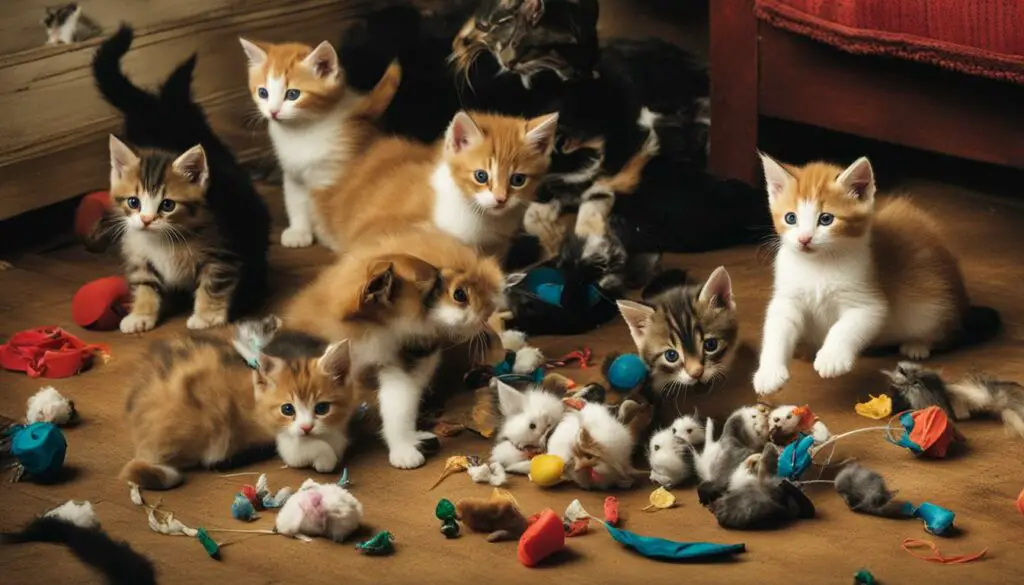
Table: Suitable Toys for Kittens
| Toy Type | Description |
|---|---|
| Interactive Wand Teasers | These toys mimic the movement of prey, stimulating your kitten’s hunting instincts and providing a healthy outlet for their energy. |
| Teething Chew Toys | Specifically designed to soothe teething discomfort by providing a textured surface for chewing. Look for toys made from soft rubber or fabric. |
| Puzzle Toys | These toys require kittens to solve puzzles or manipulate objects to access treats. They provide mental stimulation and help redirect biting behavior. |
| Feather Toys | Feather toys mimic the movement of birds, capturing your kitten’s attention and encouraging them to engage in healthy play. |
Remember, patience and consistency are key when teaching kittens appropriate boundaries. Avoid using your hands or feet as play toys, as this may confuse them into thinking it’s acceptable to bite during playtime. With time and proper guidance, your kitten will learn to direct their biting behavior towards suitable toys and interact with you in a gentle and playful manner.
Unwanted Petting: Recognizing Your Cat’s Preferences
Petting our cats is one of the ways we show affection and bond with them. However, it’s important to recognize that not all cats enjoy being petted for extended periods or in certain ways. Each cat has their own preferences when it comes to physical contact, and it’s essential for owners to be aware of these preferences to maintain a positive and respectful relationship.
Shorter petting sessions are often more enjoyable for cats, especially if they are sensitive or easily overstimulated. Instead of petting your cat for a long time, try shorter bursts of affection, paying attention to their reactions. If your cat starts to show signs of discomfort, such as twitching tail or tense body language, it’s a clear indication that they’ve had enough and would like their personal space.
Giving your cat the choice to walk away from petting is crucial. Cats are independent creatures and need to feel in control of their interactions. If your cat wants to leave or retreat to their safe space, allow them to do so without forcing them to stay. Respecting their boundaries demonstrates your understanding and consideration of their preferences.
To encourage your cat to approach you for petting, try using positive reinforcement techniques. Offer treats or praise when your cat initiates physical contact with you. By doing this, you are creating a safe and rewarding environment for your cat, where they feel comfortable seeking attention on their own terms.
| Unwanted Petting Tips | Summary |
|---|---|
| Keep petting sessions short and sweet | Respecting your cat’s boundaries and avoiding overstimulation |
| Observe signs of discomfort | Twitching tail, tense body language, or attempts to move away |
| Allow your cat to walk away | Respect their need for personal space and control |
| Use positive reinforcement | Reward your cat when they initiate physical contact |
I’ve learned that it’s important to listen to my cat’s cues and respect their boundaries. By keeping petting sessions short and allowing them to walk away when they’ve had enough, I’ve created a more harmonious and enjoyable environment for both of us. It’s amazing to see how positive reinforcement has helped my cat feel more comfortable approaching me for affection. Understanding their preferences has deepened our bond and made our relationship even stronger.
Lack of Human Interaction During Early Ages: Building Trust
Cats that have had insufficient contact with humans in their early years may exhibit behavior issues and fear towards humans. Proper kitten socialization involving gradual exposure to humans can help them build trust and reduce fear. Positive reinforcement techniques and patience in gaining their trust are essential to overcoming these behavior challenges.
When kittens are not properly socialized during their early ages, they may develop a fear of humans, leading to behavior issues such as aggression or avoidance. This fear can stem from a lack of positive experiences with humans or traumatic encounters. To help your kitten overcome this fear, it is important to gradually expose them to human interaction in a safe and controlled manner. This can be done by allowing them to observe humans from a distance, offering treats or toys as rewards for positive interactions, and providing a calm and reassuring environment.
Positive reinforcement plays a crucial role in building trust and confidence in kittens. By rewarding desirable behaviors with praise, treats, or playtime, you can help your kitten associate human interaction with positive experiences. It is important to be patient and understanding, as building trust takes time and consistency. Avoid forcing your kitten into uncomfortable situations and allow them to approach you at their own pace.
Benefits of Gradual Exposure and Positive Reinforcement
Gradual exposure and positive reinforcement are powerful tools when it comes to socializing kittens and addressing behavior issues stemming from a lack of human interaction. Here are some benefits of these techniques:
- Reduced fear: Gradual exposure to human interaction helps kittens overcome their fear and develop a sense of safety and trust.
- Increased confidence: Positive reinforcement empowers kittens and boosts their self-confidence, encouraging them to engage more comfortably with humans.
- Improved behavior: By creating positive associations with humans, kittens are more likely to exhibit desirable behaviors and less likely to display aggression or avoidance.
- Stronger bond: Building trust through gradual exposure and positive reinforcement strengthens the bond between cats and their owners, leading to a more harmonious and fulfilling relationship.

“Proper socialization is crucial in helping kittens overcome their fear of humans and building trust.”
Gradual exposure and positive reinforcement are key components in addressing behavior issues caused by a lack of human interaction. By providing kittens with carefully controlled experiences and rewarding positive behavior, we can guide them towards a more confident and trusting interaction with humans. Remember to be patient, understanding, and consistent in your efforts. Helping kittens overcome their fear and build trust is a rewarding journey that will lead to a stronger bond between you and your furry friend.
| Behavior Issues | Causes | Resolution |
|---|---|---|
| Aggression | Fear of humans, lack of socialization | Gradual exposure to humans, positive reinforcement |
| Avoidance | Fear of humans, traumatic experiences | Gradual exposure to humans, patience, and reassurance |
| Unpredictable behavior | Lack of trust, fear, and anxiety | Gradual exposure to humans, positive reinforcement, creating a calm environment |
As shown in the table, behavior issues such as aggression, avoidance, and unpredictable behavior can all be attributed to a lack of human interaction and socialization during a kitten’s early ages. By implementing gradual exposure to humans and utilizing positive reinforcement techniques, these behavior issues can be resolved, allowing kittens to build trust and develop a healthier relationship with their human companions.
Scaredy Cats: Addressing Fear-Based Aggression
Fear-based aggression in cats can be a challenging behavior to deal with. Understanding your cat’s body language and creating safe spaces are essential steps in addressing this issue. By working with a veterinarian, you can develop strategies to help your scaredy cat feel more secure and reduce fear-related aggression.
When a cat is fearful, their body language can provide valuable clues. Ears swiveling down, a crouched body posture, and tense behavior are all signs of fear. Recognizing these signs can help you identify when your cat is feeling threatened and take appropriate action.
Creating safe spaces for your cat is crucial in reducing fear-based aggression. These spaces should be quiet, comfortable areas where your cat can retreat to when they feel anxious. Providing hiding spots, such as cat trees or enclosed beds, can help your cat feel more secure. Additionally, using pheromone sprays or diffusers can create a calming environment.
| Creating Safe Spaces for Your Cat | |
|---|---|
| 1 | Set up cozy hiding spots throughout your home, such as cat trees or enclosed beds. |
| 2 | Use pheromone sprays or diffusers to create a calm and comforting atmosphere. |
| 3 | Avoid exposing your cat to situations or stimuli that trigger fear. |
| 4 | Provide plenty of vertical spaces, such as shelves or window perches, for your cat to observe their surroundings from a safe distance. |
Working with a veterinarian is essential in addressing fear-based aggression. They can help determine the underlying cause of your cat’s fear and provide behavioral modification techniques tailored to your cat’s specific needs. In some cases, medication may be necessary to alleviate your cat’s anxiety and reduce aggression.
Remember, patience and understanding are key when dealing with scaredy cats. By creating safe spaces, recognizing your cat’s body language, and seeking professional guidance, you can help your feline companion overcome fear-based aggression and live a happier, more relaxed life.
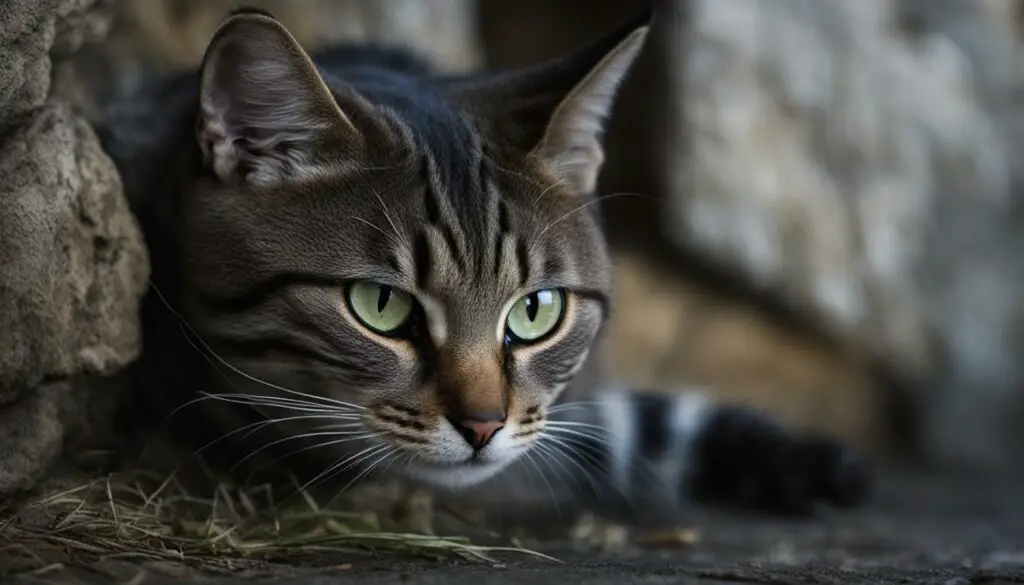
Redirected Aggression: Avoiding Accidental Attacks
Redirected aggression is a common behavior in cats when they are unable to direct their aggression towards the actual source of their arousal. This can occur when a cat becomes agitated or aroused by an external trigger, such as seeing another cat outside the window, and instead redirects their aggression towards a person or another animal in close proximity. It is important to understand and recognize the signs of redirected aggression to prevent accidental attacks and ensure the safety of both the cat and those around them.
Triggers for redirected aggression can vary, but common examples include territorial disputes, encountering unfamiliar animals, or even loud noises that startle the cat. When a cat is in a heightened state of arousal, it is crucial to avoid any interactions that may further agitate or escalate their aggression. Approaching or attempting to comfort an agitated cat during this time can result in a sudden and unexpected attack.
To prevent accidental attacks, it is recommended to create physical barriers between the agitated cat and potential targets. This can be done by using objects like furniture, pet gates, or even a sturdy cardboard barrier to prevent access to the target area. This ensures that the cat has a physical boundary and cannot reach or harm anyone while in an agitated state.
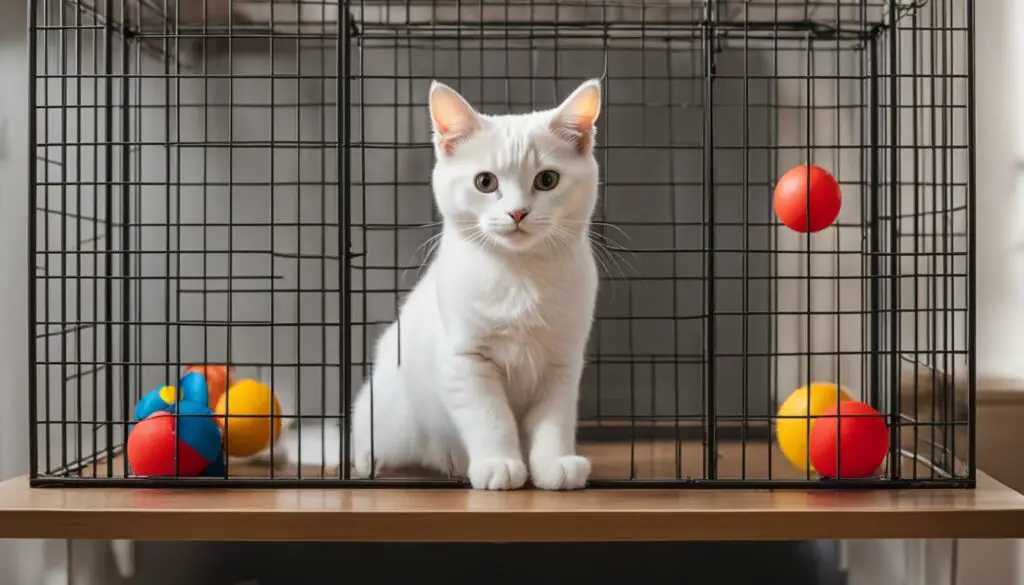
| Signs of Redirected Aggression | Prevention Techniques |
|---|---|
|
|
“Redirected aggression can be alarming and potentially dangerous, but with proper precautions and an understanding of your cat’s behavior, you can effectively manage and prevent accidental attacks,” says Dr. Emily Johnson, a feline behavior specialist.
Avoiding interactions during heightened arousal and using objects as barriers are key strategies in managing redirected aggression. It is imperative to prioritize the safety of both the cat and those around them by providing a safe environment and avoiding potential triggers. By implementing these preventive measures, cat owners can minimize the risk of accidental attacks and create a peaceful and harmonious living space for everyone involved.
Conclusion
Resolving cat biting requires a deep understanding of feline behavior. Cats may bite unprovoked due to various factors such as play mode, overstimulation, fear, or love bites. By recognizing these reasons and taking appropriate measures, cat owners can address and prevent unwanted biting behavior.
When it comes to play mode, teaching kittens appropriate behavior is crucial. Redirecting their focus towards appropriate toys when they unintentionally bite too hard during play can help them learn boundaries.
Understanding your cat’s limits during petting sessions is also important. Cats can become overstimulated, leading to unprovoked biting. Recognizing the subtle warning signs and giving cats space and respect during petting can prevent these behaviors.
Additionally, addressing fear, stress, and love bites requires patience and proper measures. Identifying triggers, providing reassurance, and establishing boundaries can help cats feel safe and reduce biting tendencies.
Resolving cat biting issues is a process that may require professional help, especially in cases of aggression or cognitive decline in senior cats. Seeking guidance from veterinarians or behavioral experts can provide valuable insights and solutions.
In conclusion, understanding feline behavior and taking the necessary steps to address and prevent biting behavior is crucial for maintaining a harmonious relationship with your cat. By building trust, providing appropriate outlets for play, and respecting boundaries, you can ensure a safe and enjoyable environment for both you and your feline companion.
FAQ
Why does my cat bite me unprovoked?
Cats may bite for various reasons, such as play mode, overstimulation, fear or stress, and love bites.
How can I teach kittens appropriate behavior?
It’s important to provide kittens with suitable toys and play sessions to redirect their focus and teach them boundaries.
What should I do if my cat exhibits petting aggression?
Recognize the warning signs of overstimulation and give your cat space and respect their boundaries during petting sessions.
How can I address my cat’s fear or stress-related aggression?
Understand your cat’s body language and provide them with reassurance and gradual exposure to new situations. Consult a veterinarian if needed.
What are love bites and how should I respond to them?
Love bites are usually gentle nibbles and can be seen as a positive behavior. If they become bothersome, ignore the behavior and reward positive behaviors.
When should I seek professional help for my cat’s aggression?
If your cat exhibits overtly aggressive tendencies, it may be necessary to consult veterinarians or behavioral experts for guidance.
How can I support cognitive function in senior cats?
Consider providing senior cats with antioxidants and nutrients. Dr. Bill’s Feline Cognitive Support is a product that can help maintain brain function in aging cats.
How can I teach kittens not to bite?
Teach kittens appropriate boundaries from a young age by providing suitable toys for biting and dedicated play sessions.
What should I do if my cat doesn’t enjoy being petted?
Respect your cat’s preferences and keep petting sessions short. Allow your cat to approach you for petting instead of approaching them.
How can I help a cat overcome fear of humans?
Gradually expose the cat to humans and use positive reinforcement techniques to build trust and reduce fear.
How can I address fear-based aggression in my cat?
Understand your cat’s body language and create safe spaces. Working with a veterinarian can provide further guidance.
How can I manage redirected aggression in my cat?
Avoid interactions during heightened arousal and use objects as barriers to prevent accidental attacks.
How can I better understand feline behavior and resolve cat biting issues?
By recognizing the various factors that contribute to biting behavior and building trust, providing appropriate outlets for play, and respecting your cat’s boundaries.

